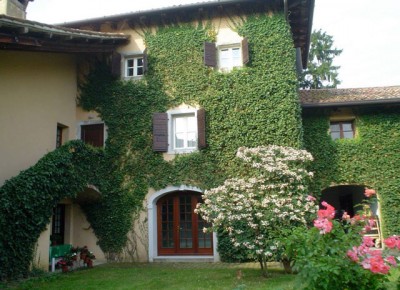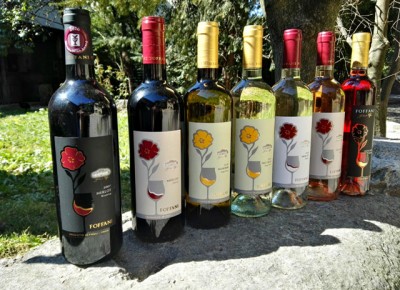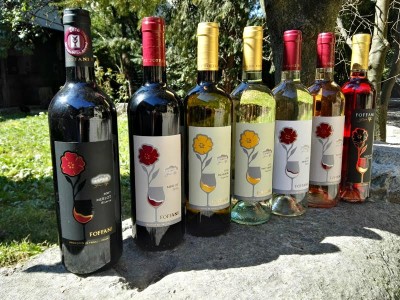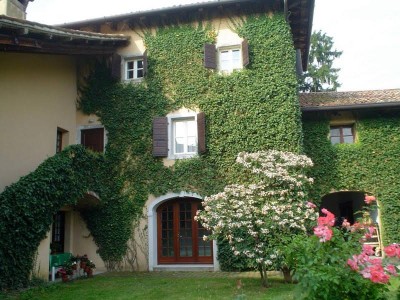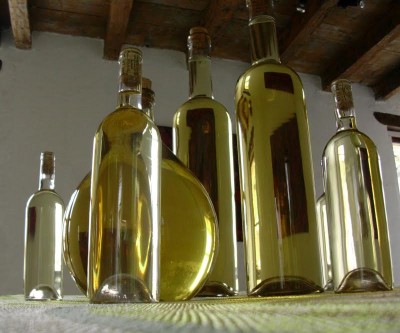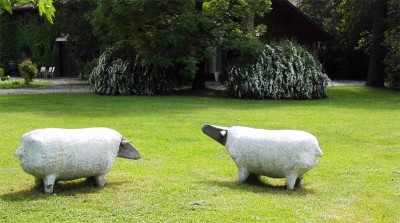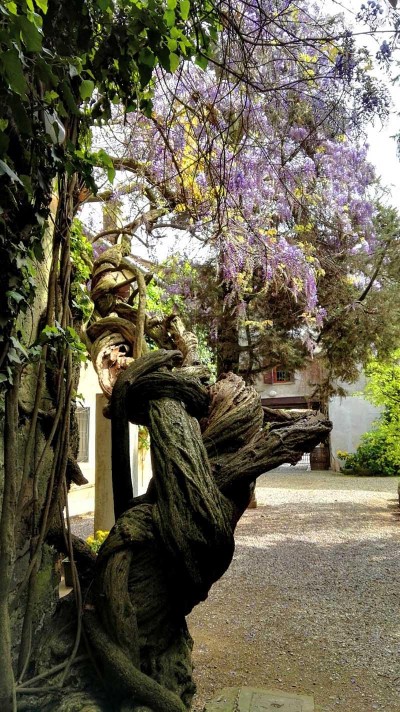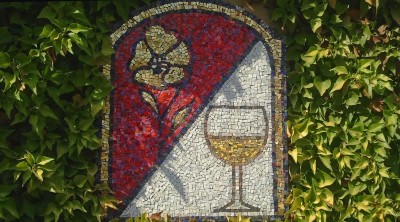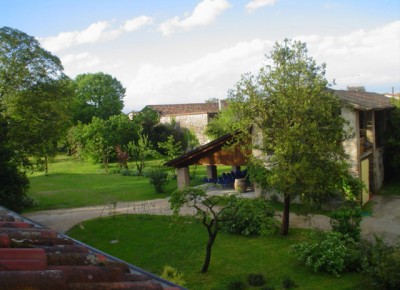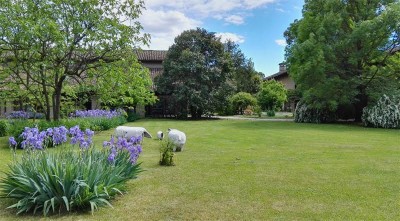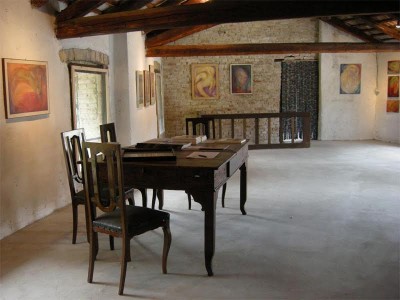Contact the abode
CASA FOFFANI AND WINERY – BED AND BREAKFAST ACCOMMODATION IN TRIVIGNANO UDINESE
It all depends which entrance you choose to walk through: Casa Foffani is so many things to so many people.
For example, if you decide to enter through the iron gate on the square, you'll be warmly greeted by a friendly, festive, child-loving little dog. As you take your first step into the courtyard, you’ll immediately realise that you've entered a parallel world where time is suspended and has been put on hold, interrupted in its flow.
If, however, you enter through the ‘Antico Cantinone’, just looking down at the ground will make you instantly aware of where your steps are taking you: we’re talking about original 400-year-old rustic paving stones, that have witnessed things that we mere mortals couldn’t even begin to imagine. And then a courtyard suddenly appears before you: hidden, secret, for your eyes only. Ancient roses gently climbing their way up to the roof.
You become aware that you need to adapt, for making any noise in that courtyard is virtually impossible. In the end, you give into it, go into contemplative mode. You fix your eyes on Maestro Candussio’s modern mosaic stems and begin to listen to the stillness and hear it whispering to you. You walk along the path, immediately captivated by the weathered tree trunk of the age-old wisteria. If you're lucky enough to be visiting at the end of April, when the vine is in full bloom, you will find yourself standing under a floral miracle: a delicate lilac curtain stretching right up to the top of the tree. You idly wonder what kind of an agreement wisteria and plane tree must have made to decide to coexist in such a way. It’s a bit like they had secretly tied the knot, as it were.
You continue along the path, keeping an eye on the wisteria's endless roots, always on the lookout for other symbiotic alliances with other trees, as on and on they wend, all the way to the wine cellar. Even if it's not September, the scent of wine being processed or decanted wafts, lively and fruity, in the air. It’s a joy for the senses, and yet another disconnect with real time.
After the cellar, the garden opens up before you. Whatever the season, there's always something to see or taste. In spring, before the first mowing of the grass, the lawn is a carpet of blue, forget-me-nots blooming profusely. Then comes a wave of irises, ancient roses, the fragrance of the old pear tree. Each season brings its own fruits: cherries, apples, pears, apricots, figs, kiwis, persimmons and medlars.
The keyword at Casa Foffani is “hidden”. Even the garden, large though it is, is hidden. You can barely catch a glimpse it from the road. The rule is always the same: you have to enter from the square and cross the time barrier. Go inside. Let the House decide you're a welcome guest and take you under its wing. Only afterwards will you realise where you are, because it's the House that gives you the power to feel it.
On the right-hand side in the first section of the garden, there are some unusual ‘presences’: they are silent, motionless in the grass, and very lazy. Strange creatures. Maybe not even real animals. In short, they make their presence felt.
At the end of the garden is the vineyard, the place that wine inhabits before it becomes wine. It is there that the magical plants absorb the elements, converse with the rain, the wind, the evening breeze in summer, the thunderstorms... and later the fog, the snow... They absorb the sky and the sun. And the grapes know all their stories.
Walk back through the other courtyard, the one that is more open and larger, the one the tractors pass through. You will also see the legendary old blue Ford, still going strong in the countryside. No one knows how old he is, but he wears his years well. When he’s been given a good polish, he can still look quite handsome.
And there's the ancient granary where concerts are held: small groups of enthusiasts gathering together on summery evenings, with live music and a chorus of birds in the background. Inside these walls at Casa Foffani, time marches to its own rhythm.
It's a small, cocooned world, a world within the external world. An ancient bourgeois house in a well-preserved rural setting. Walls impregnated with memories. Silent walls. All the silence you need.
Outside in the real world, life races by, eternally impatient. In here, life walks at a its own pace, ever timely, ever placing its feet firmly on the ground. Welcome to our world!
THE HISTORY OF CASA FOFFANI
The village of Clauiano is predominantly composed of mansions and buildings dating back to the 18th century or transformed during that period. It represents an excellent example of traditional and rural Friulian architecture, devoid of invasive interventions or contrasting additions on the main streets. One of the most prominent properties on the square is the Calligaris manor house complex, now belonging to the Foffani family. The main residence and its outbuildings have almost the same configuration today as the one reproduced on an ancient map from 1774. It has always been inhabited by the Calligaris family, as documented in records dating back to 1608 and 1687. Today, the sole owner is Giovanni Foffani, son of Maria Calligaris.
THE FARMHOUSE AND THE AGRICULTURAL ESTATE
The main house dates back to the 15th/16th century. The complex is an example of rural and bourgeois architecture, historically intended as an agricultural estate, particularly for the production of wine (officially documented since 1789) and silkworm breeding. In 1704, part of the courtyard was sold, which was followed by the construction of the 'little turret', which is now used as a charming Bed & Breakfast, and which features ancient wooden stairs and has period stuccos on the ceilings of the first floor. Other outbuildings were built in the same period, the surrounding wall was erected and the entrance was moved to the present-day Piazza. In the 19th century, the façade of the main building was clad in rusticated ashlar to half height.
During the Second World War, the house served first as the headquarters for the German and then subsequently for the American commands.
Now a winery, the Foffani estate offers a valid testimony of an architectural reality that is linked more closely to rural and bourgeois tradition than to gentrified construction. Dominantly located on the village square, it is directly connected to the vineyards behind it. Its agricultural vocation is therefore as strong today as it was 400 years ago.
MEMORIES OF WORLD WAR II
Taken from Giovanni Foffani's “Questa casa e la Guerra” (‘This House in Wartime’):
“Maria Teresa Calligaris lived in this house with her father Piero, my grandfather, her mother Ida, my grandmother, and her sister Nelsa throughout the entire Second World War. However, she and her family didn't live there alone. The house had quickly been requisitioned, bar two rooms, by the Germans, who turned it into the headquarters for their area command and stayed there for many years, until the retreat. Grandfather's family ate lunch in the dining room, while the Germans used the larger kitchen. I don't have many specific stories of those times, but I do know that he continued to roam the fields with the dogs, always with a loaded hunting rifle on his shoulder... just in case some ill-intentioned person showed up. But he never used it. During the day sometimes, the soldiers would go into the barn and shoot at the walls, and they still bear the marks of those bullets today. In the evenings, they would retreat to their bedrooms, and I believe that the coexistence was actually quite civilised and that everyone respected each other's distances.
After the episode of the attempted execution of the hostages in front of the church and the hasty retreat (or capture, I don't know which) of the Germans, the house continued to be occupied, but this time by the Americans, with whom a friendly relationship was immediately established. It's strange to think that the soldiers of the two armies had both been allies of Italy, albeit at different times.
Towards the end of the war, my father began to appear from time to time. He would ride his motorcycle from Padua after having spent two years in Albania with the Val Leogra Alpine Battalion of the Julia Division. They were hungry in the city, and the day the waitress told him in the morning that “the professor ate an entire wheel of cheese from the cellar” went down in history”.
FACILITIES AND SERVICES AT CASA FOFFANI AND WINERY
WINE TASTING
Tasting our wines is commonly requested in conjunction with group visits of the winery. We provide detailed explanations of the terroir, the different production techniques and offer a comprehensive exploration of each individual wine. Our aim is to communicate and convey the characteristics of the grape varieties, the unique traits of each vintage, the history behind each wine, and above all, its emotional personality.
We believe that an essential part of the pleasure that this ancient beverage conveys is missing unless you feel the emotion of tasting a good wine. The tastings are always conducted professionally and are available in different languages and with different degrees of complexity.
GUIDED TOURS
Individual or group guided tours of the winery, by appointment, including an immersive experience in the typical atmosphere of Casa Foffani. Various cold snacks based on local cured meats and cheeses are offered, which can be enjoyed outdoors in the romantic main courtyard during the good weather.
ANTHROPOSOPHICAL ARTIST MARGHERITA GABRIELLI
The complete works of anthroposophical artist Margherita Gabrielli are also housed in the ancient granary. The collection is visitable by appointment and for small groups only. It offers an intriguing artistic journey for those receptive to this unique genre of painting and art form, as well as those who wish to learn more about Steiner's philosophy and anthroposophy in general. Viewing Margherita’s work is a rare and hidden treasure for anyone hungry to discover the exceptional.
B&B ACCOMMODATION
A gracious apartment with two bedrooms, each with a private bathroom, are located in the ivy-covered tower, overlooking the village rooftops and the extensive garden. The two rooms can be booked individually or together as an apartment with the use of a small kitchen.
ANNUAL CLOSURE
Casa Foffani’s Bed & Breakfast and the Ancient Winery are closed during the months of December and January.
PLACES OF INTEREST IN THE VICINITY
Situated in the heart of Friuli, this small B&B is an excellent base for family holidays and for those who wish to explore the Friulian countryside, given its proximity to all the major local historical and touristic attractions neaby: seaside towns like Grado, Sistiana or Lignano, the Friulian mountains, cities of culture and UNESCO World Heritage sites such as Palmanova, Aquileia, Cividale or Udine, Trieste and even Venice! All destinations within easy reach of Clauiano, one of Italy's most beautiful villages, promising a experience where you will never be short of new things to see and do.

